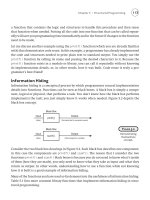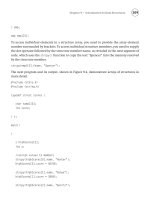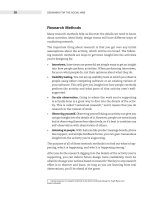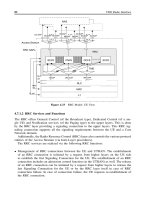Programming Groovy dynamic productivity for the java developer phần 8 potx
Bạn đang xem bản rút gọn của tài liệu. Xem và tải ngay bản đầy đủ của tài liệu tại đây (177.15 KB, 31 trang )
METHOD SYNTHESIS USING METHODMISSING 218
if (method)
{
return method.invoke(this, args)
}
else
{
return metaClass.invokeMethod(this, name, args)
}
}
def methodMissing(String name, args)
{
System.out.
println
"methodMissing called for $name"
def methodInList = plays.find { it == name.split(
'play'
)[1]}
if (methodInList)
{
def impl = { Object[] vargs ->
return
"playing ${name.split('play')[1]} "
}
Person.metaClass.
"$name"
= impl //future calls will use this
return impl(args)
}
else
{
throw new MissingMethodException(name, Person.class, args)
}
}
}
jack =
new Person()
println jack.work()
println jack.playTennis()
println jack.playTennis()
The output from the previous code is as follows:
intercepting call for work
working
intercepting call for playTennis
methodMissing called for playTennis
playing Tennis
intercepting call for playTennis
playing Tennis
METHOD SYNTHESIS USING EXPANDOMETACLASS 219
14.5 Method Synthesis Using ExpandoMetaClass
In Section
14.4, Method Synthesis Using methodMissing, on page 214,
you saw how to synt hesize met hods. If you don’t have the privilege to
edit the class source file or if th e class is not a POGO, that approach
will not work. You can synthesize methods using the ExpandoMetaClass
in these cases.
You already saw how to interact with MetaClass in Section
13.2, Inter-
cepting Methods Using MetaClass, on page 197. Instead of providing
an interceptor for a domain method, you implement the methodMissing( )
method on it. Let’s t ake the Person class (and the boring jack) from Sec-
tion
14.4, Method Synthesis Using methodMissing, on page 214, but
instead we’ll use ExpandoMetaClass, as shown here:
Download InjectionAndSy nthesisWithMOP/MethodSynthesisUsingEMC.groovy
ExpandoMetaClass.enableGlobally()
class Person
{
def work() {
"working "
}
}
Person.metaClass.methodMissing = { String name, args ->
def plays = [
'Tennis'
,
'VolleyBall'
,
'BasketBall'
]
System.out.
println
"methodMissing called for $name"
def methodInList = plays.find { it == name.split(
'play'
)[1]}
if (methodInList)
{
def impl = { Object[] vargs ->
return
"playing ${name.split('play')[1]} "
}
Person.metaClass.
"$name"
= impl //future calls will use this
return impl(args)
}
else
{
throw new MissingMethodException(name, Person.class, args)
}
}
jack =
new Person()
println jack.work()
println jack.playTennis()
println jack.playTennis()
METHOD SYNTHESIS USING EXPANDOMETACLASS 220
try
{
jack.playPolitics()
}
catch(ex)
{
println ex
}
The output from the previous code is as follows:
working
methodMissing called for playTennis
playing Tennis
playing Tennis
methodMissing called for playPolitics
groovy.lang.MissingMethodException:
No signature of method: Person.playPolitics()
is applicable for argument types: () values: {}
When you called work( ) on jack, Person’s work( ) was executed directly.
If you call a nonexistent meth od, h owever, it is routed to t he Person’s
MetaClass’s methodMissing( ).
4
You implement logic in this method similar
to the solution in Section 14.4, Method Synthesis Using methodMissing,
on page 214. Repeated calls to supported nonexistent method do not
incur overhead, as you can see in the previous output for the second
call to p l ayTennis( ). You cached the implementation on the first call.
In Section
13.2, Interce pting Methods Using MetaClass, on page 197,
you intercepted calls using ExpandoMetaClass’s invokeMethod(). You can
mix that with methodMissing( ) to intercept calls to both existing methods
and synthesized meth ods, as shown here:
Download InjectionAndSy nthesisWithMOP/MethodSynthesisAndInterceptio nUsingEMC.g roovy
ExpandoMetaClass.enableGlobally()
class Person
{
def work() {
"working "
}
}
Person.metaClass.invokeMethod = { String name, args ->
System.out.
println
"intercepting call for ${name}"
def method = Person.metaClass.getMetaMethod(name, args)
4. methodMissing( ) of the MetaClass will take precedence over methodMissing( ) if present in
your class. Methods of your class’s MetaClass override the methods in your class.
METHOD SYNTHESIS USING EXPANDOMETACLASS 221
if (method)
{
return method.invoke(delegate, args)
}
else
{
return Person.metaClass.invokeMissingMethod(delegate, name, args)
}
}
Person.metaClass.methodMissing = { String name, args ->
def plays = [
'Tennis'
,
'VolleyBall'
,
'BasketBall'
]
System.out.
println
"methodMissing called for ${name}"
def methodInList = plays.find { it == name.split(
'play'
)[1]}
if (methodInList)
{
def impl = { Object[] vargs ->
return
"playing ${name.split('play')[1]} "
}
Person.metaClass.
"$name"
= impl //future calls will use this
return impl(args)
}
else
{
throw new MissingMethodException(name, Person.class, args)
}
}
jack = new Person()
println jack.work()
println jack.playTennis()
println jack.playTennis()
The output from the previous code is as follows:
intercepting call for work
working
intercepting call for playTennis
methodMissing called for playTennis
playing Tennis
intercepting call for playTennis
playing Tennis
SYNTHESIZING METHODS FOR SPECIFIC INSTANCES 222
invokeMethod vs. methodMissing
invokeMethod( ) is a method of GroovyObject. methodMissing( )
was introduced later in Groovy and is part of the MetaClass-
based method handling. If your objective is to handle calls to
nonexisting methods, implement methodMissing( ) because this
involves low overhead. If your objective is to intercept calls to
both existing and nonexistin g methods, use invokeMethod( ).
14.6 Synthesizing Methods for Specific Instances
I showed how you can inject methods into specific instances of a class
in Section
14.3, Injecting Methods into Spe cific Instances, on page 212.
You can synthesize methods dynamically as well as into specific in-
stances by providing the instance(s) with a specialized MetaClass. Here
is an example:
Download InjectionAndSy nthesisWithMOP/SynthesizeInstance.groovy
class Person {}
def emc = new ExpandoMetaClass(Person)
emc.methodMissing = { String name, args ->
"I'm Jack of all trades I can $name"
}
emc.initialize()
def jack = new Person()
def paul = new Person()
jack.metaClass = emc
println jack.sing()
println jack.dance()
println jack.juggle()
try
{
paul.sing()
}
catch(ex)
{
println ex
}
SYNTHESIZING METHODS FOR SPECIFIC INSTANCES 223
The previous code reports the following:
I'm Jack of all trades I can sing
I'm Jack of all trades I can dance
I'm Jack of all trades I can juggle
groovy.lang.MissingMethodException:
No signature of method: Person.sing()
is applicable for argument types: () values: {}
Like injecting into specific instances, synthesizing methods f or specific
instances is limited to Groovy objects.
In this chapter, you learned how to intercept , inject, and synthesize
methods. Groovy MOP makes it easy to perform AOP-like activities.
You can create code that is hi ghly dynamic, and you can create highly
reusable code with fewer lines of code. You’ll put all these skills together
in the n ext chapter.
Chapter
15
MOPping Up
You’ve seen how to synthesize methods, and i n this chapter, you’ll see
how to synthesize an entire class. Rather than creating explicit classes
ahead of time, you can create classes on the fly, which gi ves you more
flexibility. Delegation is better than inheri tance, yet it has been hard to
implement in Java. You’ll see how Groovy MOP allows method delega-
tion with only one line of code. I’ll wrap this chapt er up by reviewing the
different MOP techniques you’ve seen in the previous three chapters.
15.1 Creating Dynamic Classes with Expando
In Groovy you can create a class entirely at runtime. Suppose you’re
building an application that will configure devices. You don’t have a
clue what these devices are—you know only that devices have proper-
ties and configuration scripts. You don’t have the luxury of creating an
explicit class for each device at coding time. So, you’ll want to synthe-
size classes at runtime t o interact with and configure these devices. In
Groovy, classes can come to life at runtime at your command.
The Groovy cl ass that gives you the ability to sy nthesize classes dyn am-
ically is Expando, which got its name because it is dynamically expand-
able. You can assign properties and methods to it either at construc-
tion time using a Map or at any time dynamically. Let’s start wit h an
example to synthesize a class Car. I’ll show two ways to create it using
Expando.
CREATING DYNAMIC CLASSES WITH EXPANDO 225
Download MOPpingUp/Us i ngExpando.groovy
carA = new Expando()
carB = new Expando(year: 2007, miles: 0)
carA.year = 2007
carA.miles = 10
println
"carA: "
+ carA
println
"carB: "
+ carB
The output from the previous code is as follows:
carA: {year=2007, miles=10}
carB: {year=2007, miles=0}
You created carA, the first i nstance of Expando, without any properties
or methods. You injected the year and miles later. On the other hand,
you created carB, the second instance of Expando, with the year and
miles initialized at construction ti me.
You’re not restricted to propert i es. You can define meth ods as well and
invoke them like you would invoke any method. Let’s give that a try.
Once again, y ou can define a method at construction time or inject
later at will:
Download MOPpingUp/Us i ngExpando.groovy
car = new Expando(year: 2007, miles: 0, turn: { println
'turning '
})
car.drive = {
miles += 10
println
"$miles miles driven"
}
car.drive()
car.turn()
The output from the previous code is as follows:
10 miles driven
turning
Suppose you have an input file wit h some data for Cars, as shown here:
Download MOPpingUp/ca r.dat
miles, year, make
42451, 2003, Acura
24031, 2003, Chevy
14233, 2006, Honda
You can easily work with Car objects without expl i citly creating a Car
class, as in the following code. You’re parsing the content of the file, first
CREATING DYNAMIC CLASSES WITH EXPANDO 226
extracting the property names. Then you create instances of Expando,
one for each line of data in the input file, and populate it with values
for the properti es. You even add a method, in the form of a closure, to
compute the average miles driven per year until 2008. Once the objects
are created, you can access the properties and call methods on them
dynamically. You can also address the methods/properties by name, as
shown in th e end.
Download MOPpingUp/DynamicObjectsUsingExpando.groovy
data = new File(
'car.dat'
).readLines()
props = data[0].split(
", "
)
data -= data[0]
def averageMilesDrivenPerYear = { miles.toLong() / (2008 - year.toLong()) }
cars = data.collect {
car = new Expando()
it.split(
", "
).eachWithIndex { value, index ->
car[props[index]] = value
}
car.ampy = averageMilesDrivenPerYear
car
}
props.each { name ->
"$name "
}
println
" Avg. MPY"
ampyMethod =
'ampy'
cars.each { car ->
for(String property : props) { print
"${car[property]} "
}
println car.
"$ampyMethod"
()
}
// You may also access the properties/methods by name
car = cars[0]
println
"$car.miles $car.year $car.make ${car.ampy()}"
The output from the previous code is as follows:
miles year make Avg. MPY
42451 2003 Acura 8490.2
24031 2003 Chevy 4806.2
14233 2006 Honda 7116.5
42451 2003 Acura 8490.2
METHOD DELEGATION: PUTTING IT ALL TOGETHER 227
Use Expando w hen ever you want to synthesize classes on the fly. It is
lightweight and flexible. One place where you will see them shine is to
create mock objects for unit testing (see Section 16.8, Mocking Using
Expando, on page
251).
15.2 Method D elegation: P utting It All Together
You use inheritance to extend the behavior of a class. On the other
hand, you use delegation to rely upon contained or aggregated objects
to provide the behavior of a class. Choose inheritance if your intent is to
use an object in place of another object. Choose delegation if the intent
is to simply use an object. Reserve inheritance for an is-a or kind-of
relationship only; you should prefer delegation over inheritance most
of the time. However, it’s easy to program inherit ance, because it takes
only one keyword, extends. But it’s hard to program delegation, because
you have to write all those methods that route the call to the contained
objects. Groovy helps you do the right thing. By using MOP, you can
easily implement delegation with a single line of code, as you’l l see in
this section.
In the following example, a Manager wants to delegate work t o either
a Worker or an Expert. You’re using methodMissing( ) and Expando Meta-
Class to realize this. If a method called on the instance of Manager does
not exist, its methodMissing( ) routes it to either the Worker or th e Expert,
whichever respondsTo( ) to th e method (see Sect i on
12.2, Querying Meth-
ods and Properties, on page 190). If there are no takers for a method
among t he delegates and the Manager does not handle it, the met hod
call fails.
Download MOPpingUp/Delegation.groovy
ExpandoMetaClass.enableGlobally()
class Worker
{
def simpleWork1(spec) { println
"worker does work1 with spec $spec"
}
def simpleWork2() { println
"worker does work2"
}
}
class Expert
{
def advancedWork1(spec) { println
"Expert does work1 with spec $spec"
}
def advancedWork2(scope, spec)
{
println
"Expert does work2 with scope $scope spec $spec"
}
}
METHOD DELEGATION: PUTTING IT ALL TOGETHER 228
class Manager
{
def worker = new Worker()
def expert = new Expert()
def schedule() { println
"Scheduling "
}
def methodMissing(String name, args)
{
println
"intercepting call to $name "
def delegateTo = null
if
(name.startsWith(
'simple'
)) { delegateTo = worker }
if(name.startsWith(
'advanced'
)) { delegateTo = expert }
if (delegateTo?.metaClass.respondsTo(delegateTo, name, args))
{
Manager.metaClass.
"${name}"
= { Object[] varArgs ->
return delegateTo.invokeMethod(name,
*
varArgs)
}
return delegateTo.invokeMethod(name, args)
}
throw new MissingMethodException(name, Manager.class, args)
}
}
peter =
new Manager()
peter.schedule()
peter.simpleWork1(
'fast'
)
peter.simpleWork1(
'quality'
)
peter.simpleWork2()
peter.simpleWork2()
peter.advancedWork1(
'fast'
)
peter.advancedWork1(
'quality'
)
peter.advancedWork2(
'protype'
,
'fast'
)
peter.advancedWork2(
'product'
,
'quality'
)
try
{
peter.simpleWork3()
}
catch(Exception ex)
{
println ex
}
The output from the previous code is as follows:
Scheduling
intercepting call to simpleWork1
worker does work1 with spec fast
worker does work1 with spec quality
METHOD DELEGATION: PUTTING IT ALL TOGETHER 229
intercepting call to simpleWork2
worker does work2
worker does work2
intercepting call to advancedWork1
Expert does work1 with spec fast
Expert does work1 with spec quality
intercepting call to advancedWork2
Expert does work2 with scope protype spec fast
Expert does work2 with scope product spec quality
intercepting call to simpleWork3
groovy.lang.MissingMethodException:
No signature of method: Manager.simpleWork3()
is applicable for argument types: () values: {}
You figured out a way to delegate calls, but that’s a lot of work. You
don’t want to put in so much eff ort each time you want to delegate. You
can refactor this code for reuse. Let’s first look at how the refactored
code will look like when used in the Manager class:
Download MOPpingUp/DelegationRefactored.groovy
class Manager
{
{ delegateCallsTo Worker, Expert, GregorianCalendar }
def schedule() { println
"Scheduling "
}
}
That is sh ort and sweet. In the initializer block you call a yet-to-be-
implemented method named delegateCallsTo() and send the names of
classes to which you want to delegate unimplemented methods. If you
want to use delegation in anoth er class, all it takes now is that code in
the initialization block. Let’s take a look at the fancy delegateCallsTo( )
method:
Download MOPpingUp/DelegationRefactored.groovy
ExpandoMetaClass.enableGlobally()
Object.metaClass.delegateCallsTo = {Class klassOfDelegates ->
def objectOfDelegates = klassOfDelegates.collect { it.newInstance() }
delegate.metaClass.methodMissing = { String name, args ->
println
"intercepting call to $name "
def delegateTo = objectOfDelegates.find {
it.metaClass.respondsTo(it, name, args) }
METHOD DELEGATION: PUTTING IT ALL TOGETHER 230
if (delegateTo)
{
delegate.metaClass.
"${name}"
= { Object[] varArgs ->
def params = varArgs?:null
return delegateTo.invokeMethod(name,
*
params)
}
return delegateTo.invokeMethod(name, args)
}
else
{
throw new MissingMethodException(name, delegate.getClass(), args)
}
}
}
When you call delegateCallsTo( ) from within your class’s instance ini-
tializer, it adds a methodMissing( ) to the class, which is known within
this closure as delegate. It takes t he Class list provided as an argument
to delegateCallsTo( ) and creates a list of delegates, which are the can-
didates to implement delegated methods. In methodM i ssi ng( ), the call
is routed to an object among the delegates that will respond to t he
method. If there are no takers, the call fails. The list of classes given to
delegateCallsTo( ) also represents the order of precedence, and the first
one has the highest precedence. Of course, you have to see all this in
action, so here is the code to exercise the previous example:
Download MOPpingUp/DelegationRefactored.groovy
peter = new Manager()
peter.schedule()
peter.simpleWork1(
'fast'
)
peter.simpleWork1(
'quality'
)
peter.simpleWork2()
peter.simpleWork2()
peter.advancedWork1(
'fast'
)
peter.advancedWork1(
'quality'
)
peter.advancedWork2(
'protype'
,
'fast'
)
peter.advancedWork2(
'product'
,
'quality'
)
println
"Is 2008 a leap year? "
+ peter.isLeapYear(2008)
try
{
peter.simpleWork3()
}
catch(Exception ex)
{
println ex
}
REVIEW OF MOP TECHNIQUES 231
The previous code produces the following output:
Scheduling
intercepting call to simpleWork1
worker does work1 with spec fast
worker does work1 with spec quality
intercepting call to simpleWork2
worker does work2
worker does work2
intercepting call to advancedWork1
Expert does work1 with spec fast
Expert does work1 with spec quality
intercepting call to advancedWork2
Expert does work2 with scope protype spec fast
Expert does work2 with scope product spec quality
intercepting call to isLeapYear
Is 2008 a leap year? true
intercepting call to simpleWork3
groovy.lang.MissingMethodException:
No signature of method: Manager.simpleWork3()
is applicable for argument types: () values: {}
You can build on this idea further to meet your needs. For instance,
if you want to mix some precreated objects, you can send them as an
array to the first parameter of dele gateCallsTo( ) and have those objects
used along with those created from the delegates classes. The previous
example shows how you can use Groovy’s MOP to implement dynamic
behavior such as method delegation.
15.3 Review of MOP Techniques
You’ve seen a number of options t o i ntercept, inject, and synthesize
methods. In this section, you’ll figure out which option is right for you.
Options for Method Interception
I discussed method interception in Chapter 13, Intercepting Methods
Using MOP, on page 194 and in Section 14.1, Injecting Methods Using
Categories, on page 203. You can use GroovyInterceptable, Ex p andoMeta-
Class, or categories.
If you have the privilege to modify the class source, you can implement
GroovyInterceptable on the class you want to intercept method call s. The
effort is as simple as implementing invokeMethod().
If you can’t modify the class or if the class is a Java class, then you can
use ExpandoMetaClass or categori es. ExpandoMetaClass clearly st ands
REVIEW OF MOP TECHNIQUES 232
out in this case because a single invokeMethod() can take care of inter-
cepting any methods of your class. Categories, on the other hand,
would require separate methods, one per intercepted method. Also, if
you use categories, you’re restricted by the use( ) block.
Options for Method Injection
I discussed method injection in Section 14.1, Injecting Methods U sing
Categories, on page 203. You can use categories or ExpandoMetaClass.
Categories compete well with ExpandoMetaClasses f or method injection.
If you use categories, you can control the location where methods are
injected. You can easily implement different versions of method injec-
tion by using different categories. You can easily nest and mix multiple
categories as well. The control offered by categories—that method injec-
tion takes effect only within the use( ) blocks and is limited to the exe-
cuting thread—may also be considered as a restriction. If you want to
use the injected meth ods at any location and also want to inject static
method and constructors, ExpandoMetaClass is a bett er choice. Beware,
though, that Expando MetaClass is not the default MetaClass in Groovy.
Using the Exp andoMetaClass, you can inject methods into specific in-
stances of a class instead of affecting the entire class. This is available
only for POGOs, however.
Options for Method Synthesis
I discussed method inject i on in Section 14.4, Method Synthesis Using
methodMissing, on page 214. You can use methodMissing( ) on a Groovy
object or ExpandoMetaClass.
If you have the privilege to modify the class source, you can implement
the methodMissing( ) method on the class for wh i ch you want to synthe-
size meth ods. You can improve performance by injecting the method on
the first call. If you need to intercept y our methods at the same time,
you can implement GroovyInterceptable.
If you can’t modify the class or if the class is a Java class, then you
can add th e method methodMissi ng( ) to the class’s ExpandoMetaClass.
If you want to i ntercept method calls at the same time, i mplement
invokeMethod( ) on the ExpandoMetaClass as well.
Using the Ex p andoMetaClass, you can synthesize methods into specific
instances of a class instead of affecting the entire class. This is available
only for POGOs, however.
REVIEW OF MOP TECHNIQUES 233
In this and previous three chapters, you saw the power of metapro-
gramming in Groovy. You can dynamically create classes, methods, and
properties on the fly. You can intercept calls to existing methods and
even method that don’t exist. The extent to which you use metapro-
gramming depends on your application-specific needs. You know, how-
ever, that when your application demands metaprogramming, Groovy
will allow you to implement it quickly. In the remainin g chapters in
this part, you’ll see several examples wher e metaprogramming plays a
vital role—when unit testing with mock objects, creating builders, and
creating DSLs.
Chapter
16
Unit Testi ng and Mocki ng
However weak the checks performed by a compiler might be in a static
language, you don’t have even that level of support in a dynamic lan-
guage.
1
That’s why unit testing
2
is a necessary practice in dynamic
languages. Although you can easily take advantage of dynamic capa-
bilities and metaprogramming in these languages, you have to take the
time to make sure your program is doing what you expect and not just
what you typed.
There has been greater awareness of unit testing among developers in
the past few years; unfortunately, though, the adoption is not suffi-
cient. Unit testing is the software equivalent of exercising. Most devel-
opers would agree that it improves the health of their code, y et many
developers offer various reasons and excuses for not doing it.
Not only is unit testing critical for programming Groovy, but unit testing
is easy and fun in Groovy as well. JUnit is built into Groovy. Metapro-
gramming capabilities make it easy to create mock objects. Gr oovy also
has a built-in mock library. Let’s take a look at how you can use Groovy
to unit test your Java and Groovy applications.
16.1 Code in This Book and Automated Unit Tests
Unit testing is not something I provide as abstract advice. I have used
automated unit tests for all the code in this book because I’m working
with a language that’s currently evolving. Groovy features change, its
1. Unit te sting is essential for metaprogramming. As you’ll see in this chapter, fortu-
nately, metaprogramming helps a great deal with unit testing.
2. See [
Bec02], [HT03], [Rai04].
CODE IN THIS BOOK AND AUTOMATED UNIT TESTS 235
implementations change, bugs are being fixed, new features are added,
and so on. I updated my installation of Groovy on my machines quite
a few times as I was writi ng these chapters and code examples. If
an update broke an example because of a feature or implementation
change, I needed to know t hat quickly wit hout expending too much
effort. Furthermore, I refactored several examples in this book as the
book evolved. Again, I needed to know quickly that things were still
working as expected. The automated unit tests helped me sleep bet -
ter at night, because I knew that the examples were still worki ng as
expected after a language update or my own refactoring .
Soon af ter writing the first few examples, I decided to t ake a break
and figure out a way to automate the testing of all examples while
keeping the examples independent and in isolated files. Some of the
examples are functions, and some are st and-alone programs or scri pts.
Groovy’s metaprogramming capabilities, along with the ExpandoMeta-
Class and the ability to load and execute scripts, made it a breeze to
create and execute automated unit tests.
It took me a couple of hours to figure out how to get going. Whenever I
write a new example, I spend about tw o minutes or less to get the test
written for that example. That effort and time paid off within the first
few days and a few times since. So far about five examples failed as I
upgraded Groovy. More important, these tests gave me assurance that
the other examples are wor king fine and are valid.
These tests helped in at least five w ays:
• It helped further my understanding of Groovy features.
• It helped raise questions in the Groovy users mailing list that
helped fix a few Groovy bugs.
• It helped find and fix an inconsistency in Groovy documentation.
• It continues to help me ensure that all my examples are valid and
working well with the most recent version of Groovy.
• It gave me the courage to refactor any example at will, at any
time, with full confidence that my refactoring improved the code
structure but did not affect its intended behavior.
UNIT TESTING JAVA AND GROOVY CODE 236
16.2 Unit Testing Java and Groovy Code
When you install Groovy, you automatically get a unit testing frame-
work built on JUnit.
3,4
You can use it to test any code on the JVM—
your Java code, your Groovy code, and so on. Simply extend your test
class from GroovyTestC ase and implement your test methods, and you’re
all set to run y our tests.
Let’s start by writing a simple test:
Download UnitTestingWithGroovy/ListTest.groovy
class ListTest extends GroovyTestCase
{
void testListSize()
{
def lst = [1, 2]
assertEquals
"ArrayList size must be 2"
, 2, lst.size()
}
}
Even though Groovy is dynamically typed, JUnit expects the return
type of test methods to be void. So, you had to explicitly use void instead
of def when defining the test method. Groovy’s optional typing helped
here. To run the previ ous code, simply execute it like you would execute
any Groovy program. So, type the following command:
groovy ListTest
The output of executing the previous code is as follows:
.
Time: 0.006
OK (1 test)
If you’re familiar with JUnit, you already understand this output—one
test was executed successfully.
If you’re a fan of the red-green bar, you can run your unit tests from
within your IDE if it supports running tests.
3. Thanks to excellen t Java-Groovy integration, you can use any Java-based testing
framework and mock objects framework (such as EasyMock, JMock, and so on, with
Groovy).
4. Groovy extends JUnit 3.8.2 but not JUnit 4. You can use JUnit 4 with a little extra
effort. If you like to use JUnit 4 and Hamcrest matchers with Groovy, see http://groovy.
codehaus.org/Using+JUnit+4+with+Groovy
.
UNIT TESTING JAVA AND GROOVY CODE 237
Unit Tests Must be FAIR
When you write unit tests, keep in mind that the tests must be
FAIR, that is, fast, automated, isolated, and repeatable.
Tests must be fast. As you evolve your code and refactor, you
want to quickly get feedback that the code continues to meet
your expectations. If the tests are sl ow, your developers won’t
bother to run them. You want a very quick edit-and-run cycle.
Tests must be automated. Manual testing is tiring, is error
prone, and wi ll take your ti me away from important tasks on
which you’re focusing. Automated tests are like a ngels on your
shoulder—they watch you quietly as you write code and whis-
per in your ears (only) if your code violates set expectations.
They give you early feedback if your code begin s to fall apart.
You’d probably agree that you’d much rather hear from your
computer that your code sucks than from your co-worker. Auto-
mated uni t tests make you look good and dep endable. For
example, when you say you’re done, you know your code
works as intended.
Tests must be isolated. When you g ot 1,031 compilation errors,
the usual problem was a missed semicolon, right? That was not
helpful; there’s no point in one small error cascading into sev-
eral reported errors. You want a direct correlation between a
creeping bug or error and a failed test case. That will help
you identify and fix problems quickly rather than bei ng over-
whelmed by large failed tests. Isolation will ensure that one test
does not leave behind a residual state that may affect another
test. It also allows you to run the tests in any order and also to
run either all, one, or a select few tests as you desire.
Tests must be repeatable. You must be able to run the tests any
number of times and get deterministic predictable results. The
worst kind of test is the one that fails on one run and passes on
a following run with no change to any code. Threading issues,
for example, may bring about some of these issues. As another
example, if a test i nserts data with unique column constraints
into a database, then a subsequent run of the same test wi th-
out cleaning up a database will fail. This will not happen, how-
ever, and the test will be repeatable if the test roll s back the
transaction. The repeatability of tests is key to staying sane while
you rapidly evolve your application code.
UNIT TESTING JAVA AND GROOVY CODE 238
You can also call junit.swingui.TestRunn er’s run( ) method and provide it
your Groovy test class name to run your tests within th e Swing GUI
to see those red-green bars.
You may use any of the assert methods that you’re already familiar
with in JUnit. Groovy adds more assert methods for your convenience:
assertArrayEqual s( ), asser tLength( ), assertContains( ), assertToString( ), assertIn-
spect( ), assertScript( ), and shouldFail( ), to mention a few.
When writing unit tests, consider writing three types of tests: positive,
negative, and exception. Positive tests help ensure th at code is behaving
as expected. You can call this the test of the happy path. You deposit
$100 and check whether the balance did go up by $100. Negative tests
check whether the code handles, as you expect, the failure of precondi-
tions, invalid input, and so on. You make the deposit amount negative
and see what the code does. What if the account is closed? Exception
tests help determine whether the code is throw i ng the right exceptions
and behaving as expected when exceptional situations arise. What if an
automated withdrawal kicks in after an account is closed? Trust me on
this one—I had a creative bank that did just that. Thinking about tests
in terms of these types of tests helps you think through the logic you’re
implementing. You handle not only code that implements logic but also
consider boundary conditions and edge cases that often get you into
trouble.
You can easily implement positive tests by using the asserts provided
in Groovy and JUnit. Implementing negative tests and exception tests
needs a bit more work, but Groovy has a mechanism to help you, as
you’ll see in Section
16.3, Testing for Exceptions, on page 240.
Even if your main project code is in Java, consider writing your test
code in Groovy. Since Groovy is lightweight, you’ll find it is easier,
faster, and fun to write your tests in Groovy while your main code is
in Java. This is also a nice way to practice Groovy on your Java-in tense
projects.
Suppose you have a Java class Car, as shown below, in the src direct ory.
Also suppose that you’ve compiled it into the classes directory using
javac.
UNIT TESTING JAVA AND GROOVY CODE 239
Car.class resides in the classes/com/agiledeveloper directory.
Download UnitTestingWithGroovy/src/Car.java
// Java code
package com.agiledeveloper;
public class Car
{
private int miles;
public int getMiles() { return miles; }
public void drive(int dist)
{
miles += dist;
}
}
You can write a unit test for this class in Groovy, and you don’t have to
compile the test code to run it. Here are a few positive tests for the Car.
These tests are in a file named CarTest.groovy in the test directory.
Download UnitTestingWithGroovy/test/CarTest.groovy
class CarTest extends GroovyTestCase
{
def car
void setUp()
{
car = new com.agiledeveloper.Car()
}
void testInitialize()
{
assertEquals 0, car.miles
}
void testDrive()
{
car.drive(10)
assertEquals 10, car.miles
}
}
The setUp( ) method and the corresponding tearDown( ) method (not
shown in the previous example) sandwich each test call. You can ini-
tialize objects in setUp( ) and optionally clean up or reset in tearDown( ).
These two methods help you avoid duplicating code and, at the same
time, help isolate the tests from each other.
TESTING FOR EXCEPTIONS 240
To run this test, type the command groovy -classp ath classes test/CarTest.
You should see the following output:
Time: 0.003
OK (2 tests)
This output shows that two tests were executed, and both, not surpris-
ingly, passed. The first test confirmed that the Car has zero miles to
begin with, and driving a certain distance increases the miles by that
distance. Now, w rite a negative test:
void testDriveNegativeInput()
{
car.drive(-10)
assertEquals 0, car.miles
}
You set the parameter for drive( ) to the negative value -10. You decide
that the Car must ignore your drive request in this case, so you expect
the miles value to be unchanged. The Java code, however, does not
handle this condition. It modifies the miles without checking the input
parameter. When you run the previous test, you will get an error:
F
Time: 0.004
There was 1 failure:
1) testDriveNegativeInput(CarTest)
junit.framework.AssertionFailedError:
expected:<0> but was:<-10>
FAILURES!!!
Tests run: 3, Failures: 1, Errors: 0
This output shows that the two positive tests passed, but the negative
test failed. You can now fix the Java code to handle this case property
and rerun your t est . You can see that using Groovy to test your Java
code is pretty straightforward and simple.
16.3 Testing for E xceptions
Let’s n ow look at writing exception tests. One way to write them is to
wrap your method in try-catch blocks. If the method throws the expected
exception, that is, if you land in th e catch block, all is well.
MOCKING 241
If the code does not thrown any exceptions, you’ll invoke fai l( ) to indicate
the failure of the test, as shown here:
Download UnitTestingWithGroovy/ExpectException.groovy
try
{
divide(2, 0)
fail
"Expected ArithmeticException "
}
catch(ArithmeticException ex)
{
assertTrue
true // Success
}
The previous code is Java-style JUnit testing and works with Groovy
as well. However, Groovy makes it easier to write exception tests by
providing a method shouldFail( ) that elegantly wraps up t he boilerplate
code. Let’s use that to write an exception t est :
Download UnitTestingWithGroovy/ExpectException.groovy
shouldFail { divide(2, 0) }
The method shouldFail( ) accepts a closur e. It invokes the closure in a
guarded try-catch block. If no exception is thrown, it raises an exception
by calling the fai l( ) method. If you’re interested in catching a specific
exception, you can specify that information to the shouldFail( ) method:
Download UnitTestingWithGroovy/ExpectException.groovy
shouldFail(ArithmeticException) { divide(2, 0) }
In this case, shouldFail( ) expects the closure to throw ArithmeticException.
If t he code throws ArithmeticException or something that extends it, it i s
happy. If some other exception is thrown or if no exception is thrown,
then shouldFail( ) fails. You can take advantage of Groovy’s flexibility with
parentheses
5
and write the previous call as follows:
Download UnitTestingWithGroovy/ExpectException.groovy
shouldFail ArithmeticException, { divide(2, 0) }
16.4 Mocking
It’s very hard, if not impossible, to unit test a piece of large code
6
that
has dependencies. One advantage of unit testing is that it forces you
5. See Section 18.8, The Parentheses Limitation and a Workaround, on page 285.
6. “What’s large code?” Any code you can’t see entirely without scr olling down in an
editor window is large—no, don’t make your font size smaller now.
MOCKING 242
Code
Under
Test
Interface
Mock
Code
You
Depend
On
Test
Test
Test
Figure 16.1: Mocking during unit testing
to make the unit of code smaller. Smaller code is cohesive code. It also
forces you to decouple the code from its surroundings. This means less
coupling. A collateral advantage of unit testing is higher cohesion and
lower coupling, which are qualities of good design. We’ll discuss ways
to deal with dependency in this section and ways to unit test code with
dependencies in the rest of this chapter.
Coupling comes in two f orms. There’s code that depends on your code,
and there’s code that your code depends on. You need to address both
types of coupling before you can unit test your code.
The code being tested has t o be separated or decoupled from where it
is used within an application. Suppose you have some logic in a button
handler within the GUI. It’s hard to unit test that logic. So, you have to
separate this code, into a method, for you to unit test it.
Suppose you have logic that heavily depends on some resource. That
resource may be slow to respond, expensive to use, unpredictable in
behavior, or currently being developed. Thus, you have to separate that
dependency from your code before you can eff ect i vely unit test your
code. This is where stubs and mocks help.









